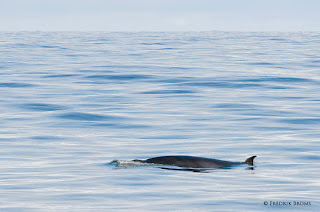Together with the bottlenose whale, the sperm whale is the deepest diving mammal in the world and may dive down to dephts as great as more than 2500m. Most dives are, however, more shallow and typically around 400 m. Being such deep divers, sperm whales are able to stay under water for the longest period of all marine mammals. Typical dives last 30-40 minutes, but they may stay under water for 1,5 hours, making the sperm whale an animal of extremes.
At sea, sperm whales are very easy to distinguish from all other whales. The blow, which is directed at an angle of 45 degrees to the left, in addition to the huge squarish head, the colouration and diving behaviour make sperm whales one of the easiest whales to identify in the field.
Diving Sperm Whale off the North Norwegian coast
Sperm Whale off the coast of Andøya in Vesterålen
Normally sperm whales only show two thirds of their body above the surface, but this old male was
swimming with the fluke very close to the water surface giving a better idea of the look of the whale.
Just before a deep dive the whales show their large head
Diving sperm whale off the Norwegian coast






















